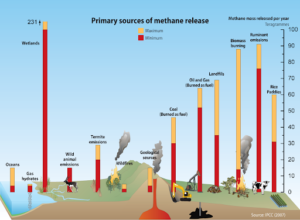
Background:
- Methane constitutes 19% of global greenhouse gas emissions and is a significant contributor to climate change.
- Key sources of human-driven methane emissions include rice production (8%), livestock (32%), and waste (18%).
- Despite its high global warming potential (GWP), 80 times more potent than CO2, methane has been less prioritized in climate action.
World Bank’s Strategy and Actions:
- The World Bank plans to launch at least 15 country-led programs within 18 months to target methane emissions.
- These programs aim to reduce methane emissions from rice cultivation, livestock, and waste management.
- The approach focuses on triple wins: cutting emissions, boosting resilience, and enhancing livelihoods.
- Funding and Partnership Platforms: Current funding for methane reduction is less than 2% of global climate finance, with plans to increase this between 2024 and 2030.
- Collaborations include Germany, Norway, the USA, the UAE, and the private sector.
- Two key platforms: Global Methane Reduction Platform for Development (CH4D) and Global Flaring and Methane Reduction Partnership (GFMR).
Initiatives to Tackle Methane Emissions | |
Indian Initiatives | Global Initiatives |
|
|
Why in News:
- The World Bank is starting new projects to tackle the increasing problem of methane gas emissions.
 Profile
Profile Settings
Settings Refer your friends
Refer your friends Sign out
Sign out






